Lucian Predescu1, Marin Postu1
1 „Prof. Dr. C.C. Iliescu” Emergency Institute for Cardiovascular Diseases, Bucharest, Romania
2 Emergency University Hospital, Bucharest Romania
Abstract: This article summarizes the activity of the interventional cardiology centers of Romania during 2017. Data was collected from all interventional cardiology centers from Romania using a standard reporting model. The report highlights the total number of coronary interventions, peripheral interventions and other procedures like TAVI, mitraclip, aortic endoprothesis, interventions in structural heart diseases, that were performed in 2017 in Romania. A comparison of the activity of the interventional cardiology centers in Romania between 2014 to 2017 was done. Keywords: interventional cardiology, percutaneous coronary interventions, stents
This article summarizes the activity of the interventi-onal cardiology centers of Romania during 2017 and it highlights the trends in different coronary or peripheral interventions between 2014 and 20171-3.
Data was collected from all interventional cardiology centers from Romania using a standard reporting model at the initiative of the interventional cardiology working group of Romanian Society of Cardiology. The purpose of this initiative was to have a clear pic-ture of the magnitude of the activity of interventional cardiologists at a national level, to know the total number of different types of procedures, and to identify any trends.
Table 1 summarizes the data from 2017 provided by 34 public and private interventional cardiology centers of Romania. Currently, there are 34 interventional cardiology centers in Romania, of which 13 are private centers and 21 public centers with 53 functional angiographs. In 2017, in Romania were 117 independent interventional cardiologists and 52 interventional cardiologists in training.
A direct comparison of 2014 with 2015 and 2016 was done, that highlights the continuous increase in the activity of the interventional cardiology centers in Romania. The total number of PCIs in 2015 increased with 35% compared to 2014, in 2016 increased with only 5% compared to 2015 and in 2017 increased with 12% compared to the previous year (Figure 1, 2). In 2017, in Romania, were made 20773 coronary interventions.
We see the same trend in the total number of implanted stents (Figure 3). The number of implanted stents per patient in 2017 was 1.46. The activity increased in both public and private hospitals (Figure 4). The total number of STEMI increased by 16% in 2016 compared to 2015 and remained almost unchanged in 2017 (Figure 5).
The utilization of intracoronary imaging (OCT and IVUS) and of invasive coronary hemodynamic measurements like IFR and FFR increased in 2017 with 68% compared to 2016 (Figure 6).
An important progress was made in peripheral angioplasty. The total number of peripheral angioplasty slightly increased from 2014 to 2016, but in 2017 there was a substantial increase with 27% compared with 2016 (Figure 7).
In 2017 the number of other types of procedures, like TAV (were reported 144 cases), mitraclip (were reported 10 cases) and aortic endoprothesis (were reported 89 cases) increased. There is a continuous need of implementing a Mandatory Interventional Cardiology National Registry, capable of monitoring objectively these key health care services in a standard manner. This national registry can guide further development of the interventional cardiology in Romania.




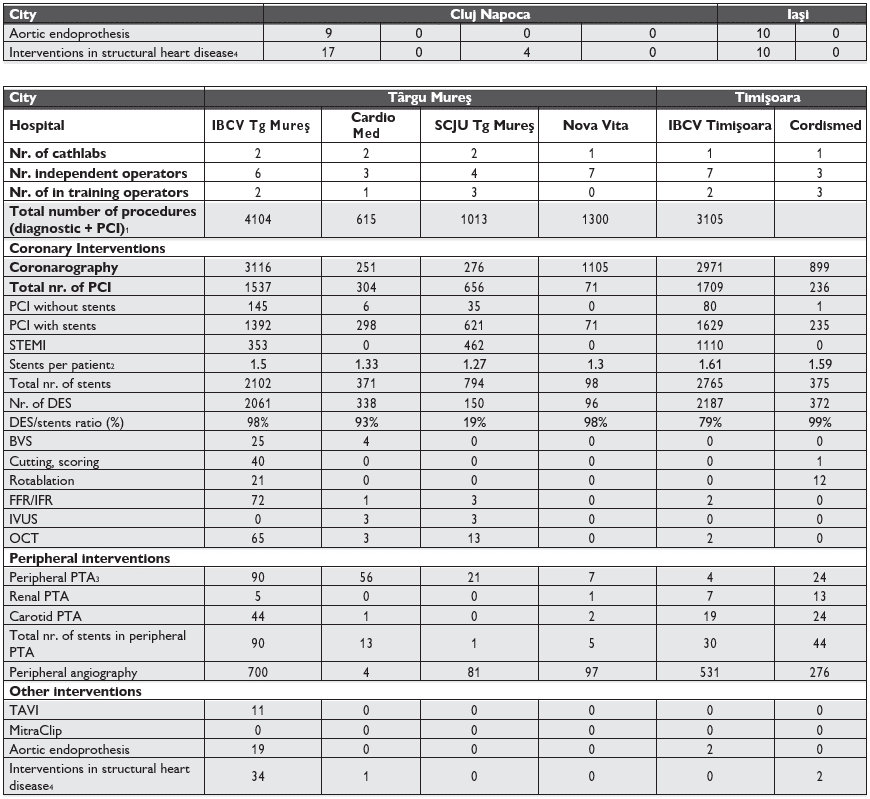

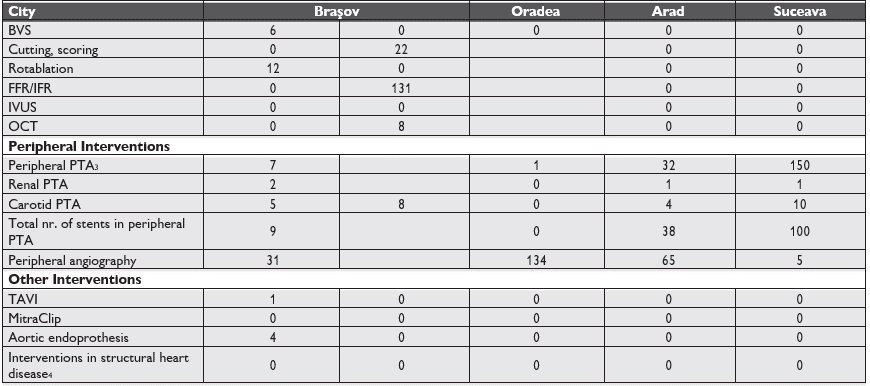
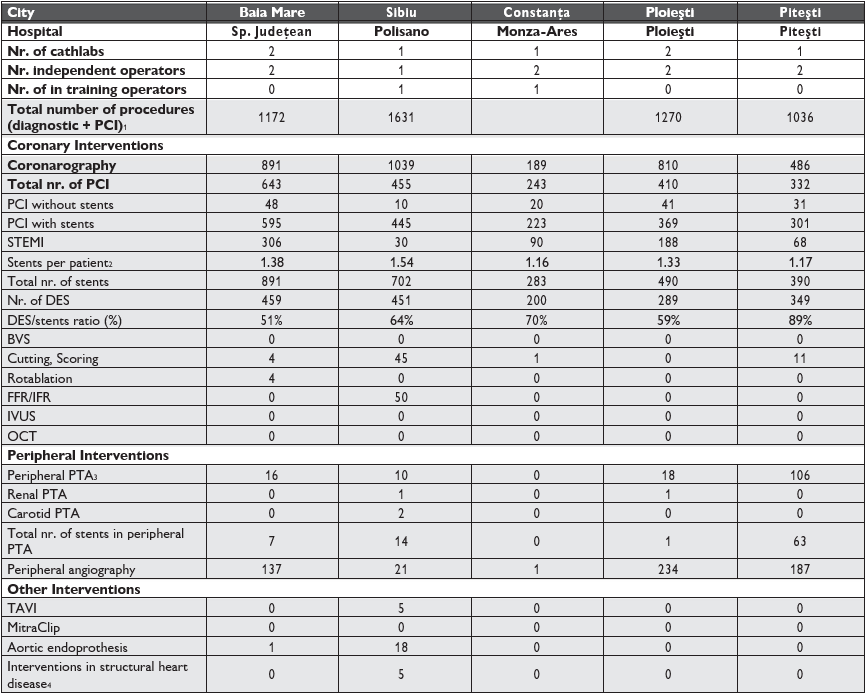
Lucian Predescu et al.
The activity of the Interventional Cardiology Centers in Romania
1 All procedures performed in the intervention center, both diagnostic and therapeutic, coronary and peripheral, will be introduced. If in the same procedure the patient is diagnosed with coro-nary angiogram followed by angioplasty, it will be described as a procedure. If a patient performs coronary angiogram, and in a subsequent session will perform angioplasty, two procedures will be considered.
2 It will represent the ratio between the total number of implanted stents and the total number of patients undergoing PCI.
3 Number of peripheral angioplasty (lower and upper limbs artery, not including carotid arteries).
4 Interventions in cardiac structural diseases: percutaneous closures of DSA, DSV, PFO, arterial duct, balloon valvulotomies, left atrial appendage closure.
5 Major bleeding: fatal bleeding, intracranial hemorrhage, bleeding with hypovolemic shock (SBP <90 mmHg), hemoglobin decreased by >3 g/dl).
PCI – percutaneous coronary intervention, STEMI – ST segment elevation myocardial infarction, DES – drug eluting stent, BVS – bioresorbable vascular scaffold, FFR – fractional flow reserve, IFR – instantaneous wave-free ratio, IVUS – intravascular ultrasound, OCT – optical coherence tomogra-phy, PTA – percutaneous transluminal angioplasty, TAVI – transcatheter aortic valve implantation.
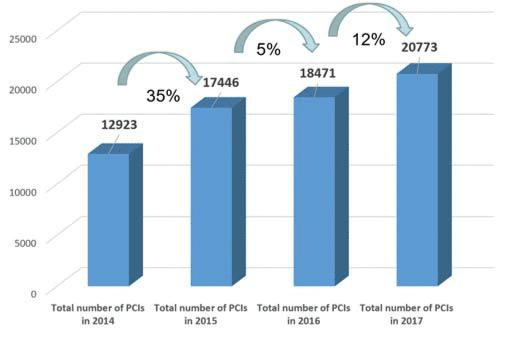
Figure 1. Total number of PCIs from 2014 to 2017 in Romania (PCI – percutaneous coronary intervention).

Figure 2. Total number of PCIs in 2017 in all interventional centers from Romania (PCI – percutaneous coronary intervention).

Figure 3. Total number of stents implanted from 2014 to 2017 in Romania. Figure 4. Total number of PCIs from 2015 to 2017 in private vs public hospitals (PCI – percutaneous coronary intervention).
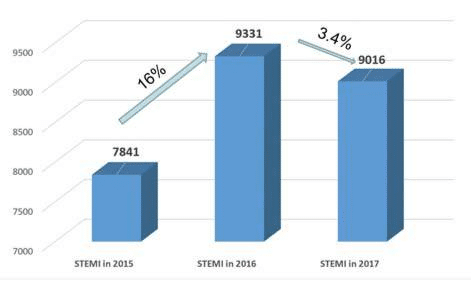
Figure 5. Total number of STEMI from 2015 to 2017 in interventional centers from Romania (STEMI – ST segment elevation myocardial infarction).
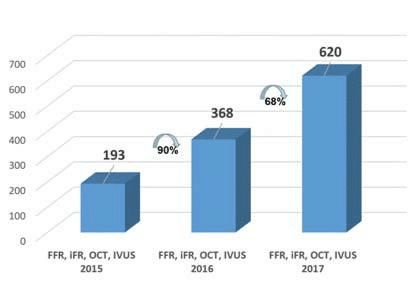
Figure 6. Invasive imaging and coronary hemodynamics testing from 2015 to 2017 (FFR – fractional flow reserve, IFR – instantaneous wave-free ratio, IVUS – intravascular ultrasound, OCT – optical coherence tomography).
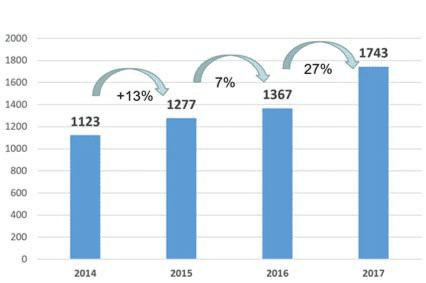
Figure 7. Total number of peripheral angioplasty from 2014 to 2017 in Romania (only in interventional cardiology centers).
Acknowledgement: We want to thank for their contribution to data collection to: Dr. Adrian Bucsa and Prof. Dr. Vlad Iliescu, „Prof. Dr. CC Iliescu” Emergency Institute for Cardiovascular Diseases, Bucharest; Dr. Cristian Udroiu and Prof. Dr. Dragos Vinereanu, Emergency University Hospital, Bucharest; Dr. Lucian Calmac, Emergency Clinic Hospital, Bucharest; Dr. Emanuel Radu, Emergency Clinical Hospital „Prof. Dr. Agrippa Ionescu „, Bucharest; Dr. Sebastian Botezatu, Central Military Emergency University Hospital „Dr. Carol Davila”, Bucharest; Dr. Valentin Chioncel, „Bagdasar-Arseni” Clinical Emergency Hospital, Bucharest; Dr. Mihai Melnic, Elias Emergency University Hospital, Bucharest; Dr. Octavian Zara, „Sf. Ioan” Clinical Emergency Hospital, Bucharest; Dr. Cristina Spinu, Sanador Clinical Hospital, Bucharest; Dr. Oren Iancovici, ARES Centers of Excellence in Cardiology and Radiology, Bucharest and Ares-Monza, Constanta; Prof. Dr. Gheorghe Dan and Dr. Emilian Mihai, Co-lentina Clinical Hospital, Bucharest; Dr. Florina Pinte, Medlife, Bucharest; Dr. Stefan Mot, Heart Institute „Niculae Stancioiu” and Cardioteam, Cluj-Napoca; Prof. Dr. Dan Olinic, County Emergency Hospital, Cluj-Napoca; Dr. Bogdan Dutu, Clinical Recovery Hospital, Cluj-Napoca; Dr. Alexandru Burlacu, Institute of Cardiovascular Diseases „Prof. Dr. George IM Georgescu”, Dr. Igor Nedelciuc, Arcadia, Iasi; Prof. Dr. Imre Benedek and Prof. Dr. Teodora Benedek, County Emergency Hospital, Targu Mures, Dr. Ayman Elkahlout and Dr. Laszlo Hadady, Emergency Institute For Cardiovascular Diseases, Targu Mures; Conf. Dr. Ioan Tilea, Nova-Vita, Targu Mures; Conf. Dr. Cristian Mornos, Institute Of Cardiovascular Disease, Timisoara; Dr. Milovan Slovenski, Cordismed, Timisoara; Dr. Mihai Ursu, Clinicco, Brasov; Dr. Florin Ortan and Cristina Popica, County Emergency Hospital, Brasov; Dr. Marius Rus, County Emergency Clinical Hospital, Oradea; Dr. Cristian Dina, Cardiolife, Arad; Dr. Ro-berto Haret, Med New Life, Suceava; Dr. Dan Filip, County Emergency Hospital “Dr. Constantin Opris”, Baia Mare; Dr. Nicolae Florescu, Polisano, Sibiu; Dr. Marian Albu, County Emergency Hospital, Ploiesti; Dr. Elvis Botu, County Emergency Hospital, Pitesti.
References:
1. Postu M, Predescu L, Mot S, The activity of the interventional cardiology centers in Romania: a 2016 overview and 2014-2016 trends, Romanian Journal of Cardiology, Vol. 27, No. 3, 2017, pag. 359-368
2. Postu M, Predescu L, Mot S, The activity of the Interventional Cardiology Centers in Romania: a 2015 overview, Romanian Journal of Cardiology, Vol. 26, No. 3, 2016, pag. 298-309
3. Postu M, Uşurelu C, Predescu L et al., Romanian interventional cardiology centers, 2014-2015: an overview, Romanian Journal of Cardiology, Vol. 25, No. 2, 2015, pag. 170-174.
 This work is licensed under a
This work is licensed under a